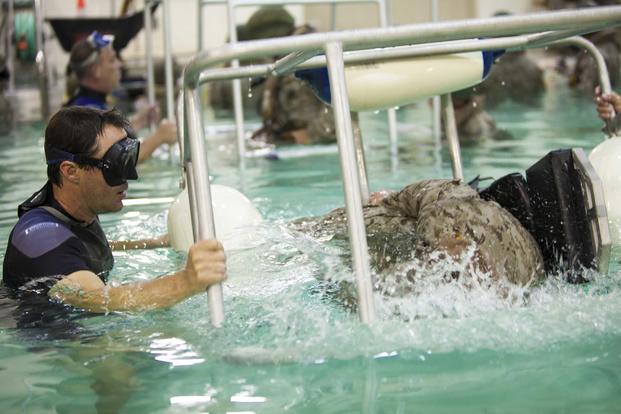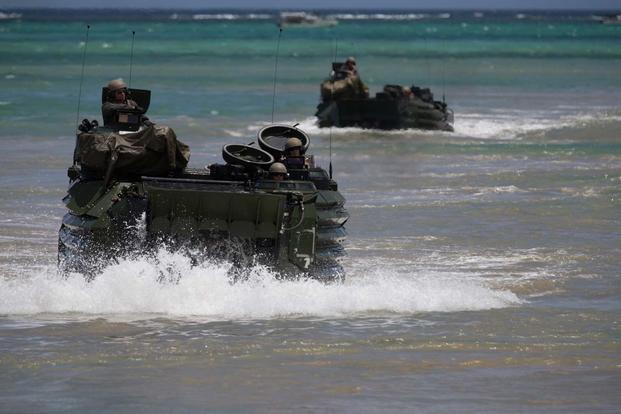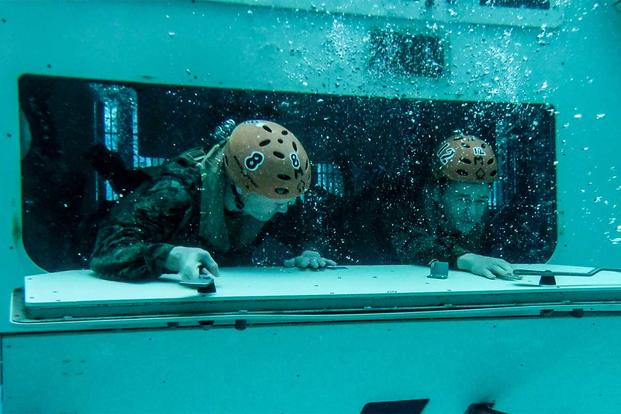A lot more Marines will be getting dunked deep thanks to a policy change requiring more intensive water egress training ahead of shipboard deployments.
An all-Marine message, quietly released Jan. 31, implements new rules governing pre-deployment training for troops assigned to Marine Expeditionary Units – massive multi-capable elements that deploy aboard three-ship Amphibious Ready Groups for global missions ranging from combat to humanitarian assistance and disaster relief.
The message, signed by Marine Corps Commandant Gen. David Berger, tightens up training requirements for troops flying over water or riding in amphibious vehicles as part of their job.
"The Modular Amphibious Egress Trainer (MAET) is required for all personnel conducting flight operations. The Submerged Vehicle Egress Training (SVET) is required for all personnel conducting amphibious vehicle waterborne operations," the message reads.
"Personnel who fail to successfully complete the SVET/MAET are not authorized to conduct overwater flight or amphibious vehicle waterborne operations."
The MAET, better known as the "Helo Dunker," consists of an open-ended chamber that represents the cabin of a CH-53 Super Stallion helicopter or V-22 Osprey. Marines are seated inside and buckled in before the chamber is lowered by crane into a training pool. The chamber is rotated multiple times as it fills with water, simulating water crash conditions. The disoriented troops inside must unbuckle their harnesses and find a way out of the mock-helicopter to pass the training.
The SVET is similar to the helo dunker, with the same "modular core and rotational capabilities," according to Marine Corps Training and Education Command. But instead of a helicopter, it's designed to resemble the proportions of a High Mobility Multi-purpose Wheeled Vehicle (HMMWV) or an AAV.
The All-Marine message goes on to state that the Shallow Water Egress Trainer, or SWET, is "not sufficient for completing either the flight operations or amphibious vehicle waterborne operations requirement." Any waivers to the training requirement must be approved by commanders at the 0-6 level, and those missing their main egress training requirement (SVET for amphibious vehicle operations, MAET for flights over water) must still have completed the alternative egress training, and water survival qualification to be waiver-eligible.
The SWET, also known as the "dunker chair," is unlike the other egress training devices in that it doesn't simulate a cabin or compartment that a service member would need to escape. The much smaller trainer consists of a chair inside a simple roll cage. A service member straps into the chair and is then manually submerged and rolled by training staff. The objective is to remove the harness, exit the cage, and reach the surface of the water: a simpler and less chaotic task than exiting a submerged and overturned helicopter or tactical vehicle in coordination with a handful of other panicked Marines.
This training change comes a year and a half after a horrific training accident in July 2020. Eight Marines and a Sailor attached to the California-based 15th Marine Expeditionary Unit (MEU) died when their amphibious assault vehicle, or AAV, sank during a training exercise off the coast of San Clemente Island. The tragedy prompted congressional hearings and a series of soul-searching accountability efforts, including the firing of two senior commanders and suspension of a two-star general; the permanent suspension of water operations for the Vietnam-era AAVs; and multiple investigations into the causes of the accident.

Ultimately the troops' deaths were attributed to "a confluence of human and mechanical failures" that included lapses in training. Most of the grunts in the back of the AAV that sank – 11 of the 13 – lacked underwater egress training due to unclear orders and logistical obstacles including a closed pool, Marine Corps Times reported. Because of that lack of familiarity with egress protocols, according to a USNI News report, the troops were flustered and unsure what to do when the vehicle began taking on water. Among the steps directed in the wake of the accident by Marine Corps Forces Pacific Commander Lt. Gen. Steven Rudder was a review of underwater egress training and procedures.
The prior order governing MEU pre-deployment workups did require elements of water survivability training, but left significant loopholes that were starkly highlighted in the AAV disaster. The order, last updated in 2019, mandates MAET or SVET dunker training for personnel designated "high risk," or conducting operations in or over water as part of their normal mission profile. However, it notes that shallow water training in the dunker chair is fine for remediation training if required. For those designated "low risk," or not conducting operations in proximity to water on a regular basis, shallow water egress training is recommended but not required, it states.

The updates to the order also require that the commanding generals of the relevant major subordinate command conduct a Marine Corps Combat Readiness Evaluation, or MCCRE, for the ground, aviation and logistics MEU elements under their purview before the elements come together, or composite, ahead of a deployment. For air units, the training should be flown live "to the maximum extent practical," though simulators may be authorized if deemed a better option.
The AAV platoon involved in the July 2020 mishap hadn't completed the MCCRE before becoming part of the 15th MEU, Rudder's investigation found, noting that a completed evaluation might have highlighted areas in which the troops weren't fully prepared.
Underwater egress training is a relatively recent addition for the Marine Corps, with the first trainers acquired in 2008. It's now offered at the four major Marine Corps Bases: Camp Lejeune, N.C., Camp Pendleton, Okinawa, Japan, and Hawaii.
In April 2021, retired Col. Walt Yates, a former Marine Corps Systems Command program manager, wrote for Task and Purpose that the lack of complete underwater egress training was a critical factor in the disaster.
"Regardless of the sum total of human and mechanical failures that contributed to last year's sinking of AAV 523519, I believe that every Marine and Sailor could have evacuated to safety," he wrote.
"The decisive factor between limiting the loss to merely the AAV and embarked equipment versus the loss of nine lives was the failure to ensure that all personnel successfully completed UET."
The training, he added, doesn't merely prepare troops for the chaos and disorientation of water submersion. It also provides response cues. As water levels begin to rise, Marines and sailors are instructed to shed equipment, including helmets, body armor and personal weapons to prepare for a water escape. But even when the water had risen waist high in the sinking AAV, investigations show, the Marines inside were still wearing their heavy gear.
Yates said another step must also be taken to ensure training is successful: the Marine Corps must budget effectively for the operation and maintenance of its underwater escape trainers to ensure the resources are available for all troops who need them.
"Marine Corps headquarters cannot be allowed to simply publish a requirement for training without allocating the budget, time, and manpower resources to deliver that training," he wrote.
"UET cannot be relegated to the status of an ‘unfunded requirement' that is below the cut-line for the budget request submitted to Congress."
Read the original article on Sandboxx












